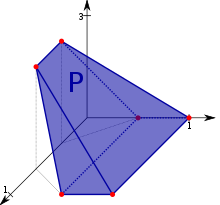
Back Lineêre programmering Afrikaans برمجة خطية Arabic Programación llinial AST Xətti proqramlaşdırma Azerbaijani Лінейнае праграмаванне Byelorussian রৈখিক কাম্যতমকরণ Bengali/Bangla Linearno programiranje BS Programació lineal Catalan پڕۆگرامی ھێڵی CKB Lineární programování Czech


Linear programming (LP), also called linear optimization, is a method to achieve the best outcome (such as maximum profit or lowest cost) in a mathematical model whose requirements and objective are represented by linear relationships. Linear programming is a special case of mathematical programming (also known as mathematical optimization).
More formally, linear programming is a technique for the optimization of a linear objective function, subject to linear equality and linear inequality constraints. Its feasible region is a convex polytope, which is a set defined as the intersection of finitely many half spaces, each of which is defined by a linear inequality. Its objective function is a real-valued affine (linear) function defined on this polytope. A linear programming algorithm finds a point in the polytope where this function has the largest (or smallest) value if such a point exists.
Linear programs are problems that can be expressed in standard form as
Here the components of are the variables to be determined, and are given vectors, and is a given matrix. The function whose value is to be maximized ( in this case) is called the objective function. The constraints and specify a convex polytope over which the objective function is to be optimized.
Linear programming can be applied to various fields of study. It is widely used in mathematics and, to a lesser extent, in business, economics, and some engineering problems. Industries that use linear programming models include transportation, energy, telecommunications, and manufacturing. It has proven useful in modeling diverse types of problems in planning, routing, scheduling, assignment, and design.
© MMXXIII Rich X Search. We shall prevail. All rights reserved. Rich X Search







